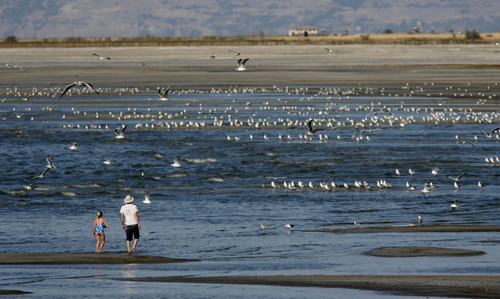This is an archived article that was published on sltrib.com in 2012, and information in the article may be outdated. It is provided only for personal research purposes and may not be reprinted.
One of the world's leading mercury scientists said Wednesday that new federal pollution controls will yield real benefits for Americans.
David P. Krabbenhoft told attendees of the Great Salt Lake Issues Forum that consumers can expect less toxic mercury in the fish they eat because of the laws. The effects will also ripple through the environment everywhere, from the oceans to the Great Salt Lake and the other 19 bodies of water around Utah where sport fish and waterfowl are highly contaminated.
The U.S. Geological Survey researcher pointed to his own studies showing that when mercury emissions are cut, so is food-chain contamination.
"Wonderful news," he said in the forum's opening session, "that I think is really the best evidence anywhere that, on an ecosystem scale, we can solidly conclude that reductions in emissions will result in … very quick responses from [natural] systems."
Krabbenhoft's talk kicked off three days of discussions by more than 100 devotees of Utah's iconic lake and the singular ecology it supports. Presenters were set to talk about preserving water quality in the Great Salt Lake, the impacts of mining on it and what's happening at other saline lakes, including those in California and Israel.
But the first day focused on mercury, with presentations of detailed scientific studies on migratory birds, brine flies, brine shrimp, microorganisms and even sediment. In 2003, researchers from Krabbenhoft's agency measured in the Great Salt Lake some of the highest concentrations of toxic methylmercury ever seen anywhere.
Speaker after speaker Wednesday pointed out that new questions arise with every completed study.
Jodi Gardberg of the Utah Division of Water Quality noted that a sweeping study of the Great Salt Lake in 2008 revealed trends in how mercury builds in the food chain. But it suggested new lines of study, including the possibility that some birds are loading up with mercury before they even get to the lake and the booster effect that selenium appears to have on the transformation of mercury from its elemental form to its poisonous form that causes so much concern.
Krabbenhoft noted that, even after decades of solid mercury research, it remains unclear what happens when the contaminant encounters certain conditions in the environment, conditions that sometimes temper and sometimes magnify its harmful impacts.
"It's not just about emissions" from regulated industry, he said. "There's a whole lot more that has to happen before it becomes a problem."
Such things as oxygen levels, the presence of certain minerals, microorganisms — all could alter the chemistry of mercury in the natural environment.
In December, the U.S. Environmental Protection Agency announced it would require new controls on coal- and oil-fired power plants that release mercury from their stacks.
EPA Administrator Lisa Jackson hailed the new regulations as "a great victory for public health — especially the health of children."
Utah health and environmental advocates also applauded the move, 20 years in the making, for an emissions cleanup estimated to cut premature deaths by up to 11,000 annually nationwide, reduce heart attacks by 4,700 and prevent 130,000 cases a year of childhood asthma symptoms.
But industry complained the regulations threaten to put thousands of people out of work, raise electricity rates and test the reliability of the nation's electric power grid. Utah Gov. Gary Herbert wrote a letter urging a delay of the regulations and Attorney General Mark Shurtleff joined a friend-of-the-court brief objecting to them.
Meanwhile, Rocky Mountain Power said the new regulations might speed the retirement of its carbon coal-fired power plant in Price Canyon.
The company has been discussing with Utah decision-makers the possible closure of the 190-megawatt plant in 2020, but no decision has been announced yet.
fahys@sltrib.comTwitter: @judyfutah







